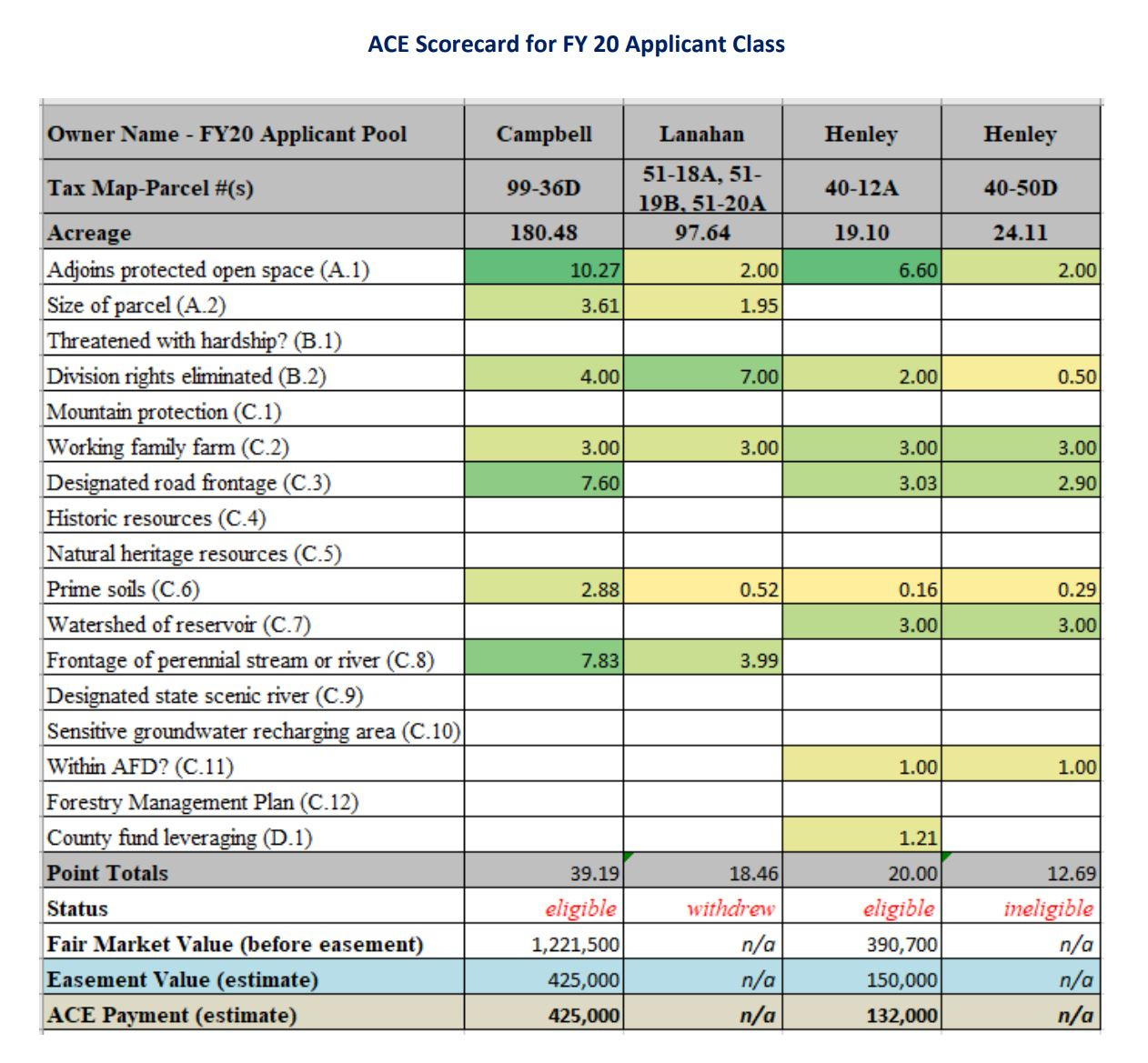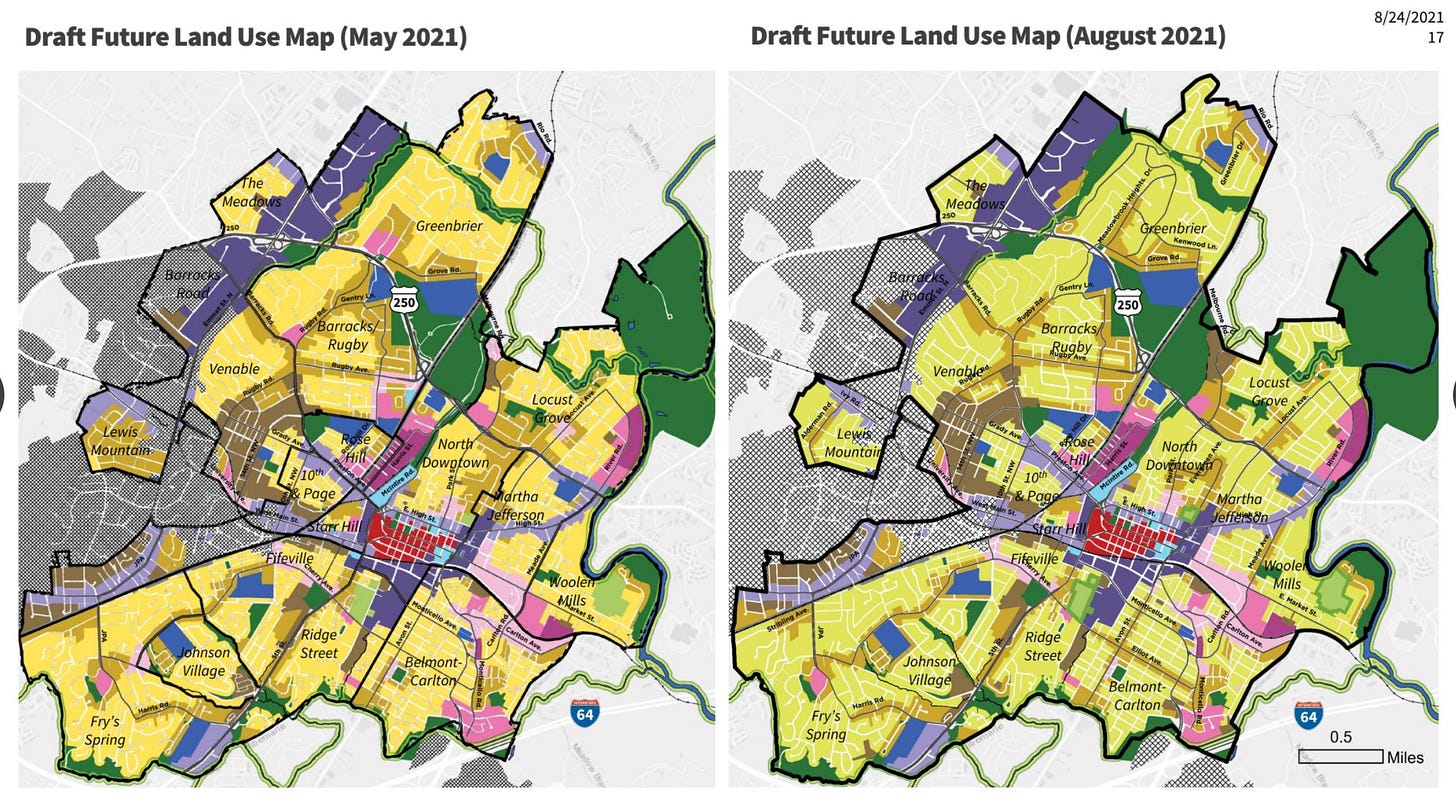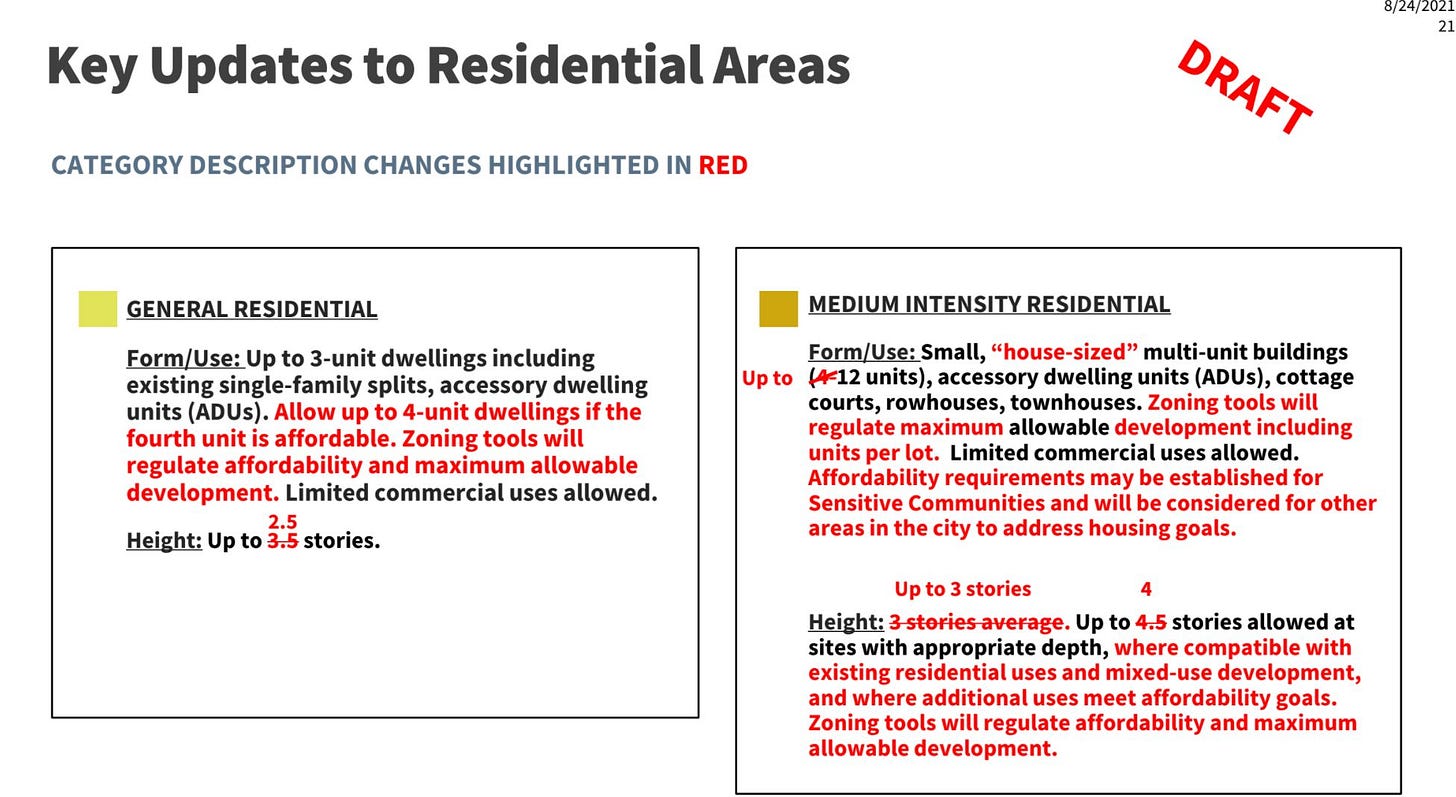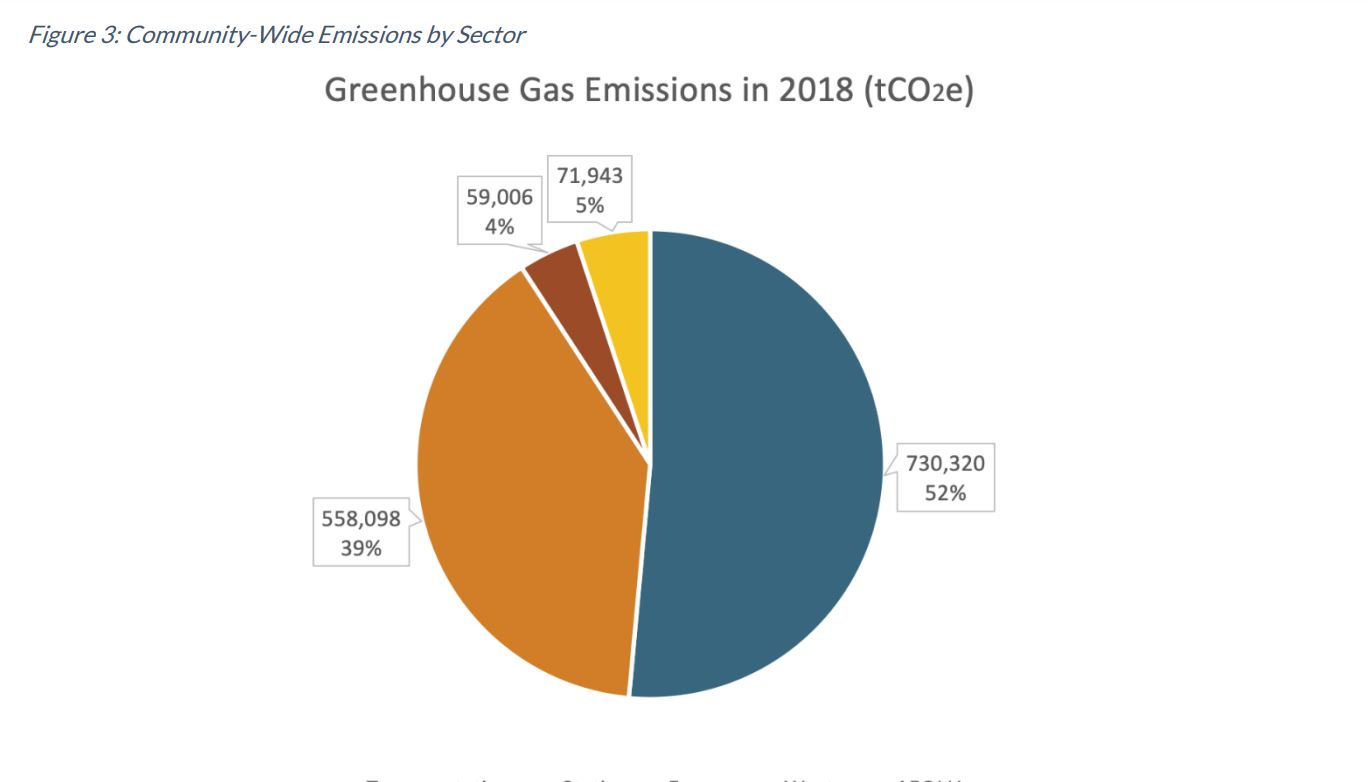This is another week split across two months, making it hard to gauge what kind of week it will actually be. Two days in August, then three days in September. Labor Day is a week away, but the Albemarle Board of Supervisors keeps us from a restful week with their first meeting of the month on Wednesday. The two meetings related to the Cville Plans Together initiative really push this week towards the busier side of the spectrum.
Greene County, Louisa County, and Nelson County appear to be taking the week off, but the Thomas Jefferson Regional Planning District Commission meets, so we’ll hear from some officials from those localities at some point in coverage in the Charlottesville Community Engagement newsletter.
Thanks as always to the Piedmont Environmental Council for their support of this work and the research that goes into it. The goal of this newsletter is to point you in the direction of information and I’m grateful to be able to do that.
Monday, August 30, 2021
Only one meeting today, and that gives me a chance to explain more about a body that would otherwise be relegated to a one-line entry in this newsletter.
The Albemarle Acquisition of Conservation Easement Committee meets at 5 p.m. According to the county’s website, the program ACE “was designed to provide a financial incentive for landowners of modest means to protect their family farm from future development.” (meeting info)
ACE is an example of a “purchase of development rights” program where a landowner agrees not to develop land in exchange for a payment. This is codified in a perpetual conservation easement. When the pandemic hit, the program was put on hold and no new properties were considered.
The FY2021 budget included no new funding for the program, but there were funds carried over from previous years. As of January 31, 2021, there was $372,283 in funding according to the draft FY22 budget.
The ACE committee reviews candidate properties, and their staff report indicates elected officials are interested in finding the money for two properties that were in the candidate pipeline when the pandemic hit.
“At a June 2, 2021 meeting, BOS directed staff to do an ‘evaluation and analysis’ of the current ACE projects so they can decide how much funding is needed,” reads the staff report. “This meeting did NOT give authority to acquire the two easements, just approval to scope and price them.”
At issue with these two properties is how to calculate the “usable development rights” for an appraisal of the easement. At the March 2020 ACE meeting, one member suggested that those development rights should be plotted out formally using a surveyor. So far these have been calculated less formally. At this meeting, the committee will vote on whether to proceed with a pilot project to hire a third party to do the appraisals.

Tuesday, August 31, 2021
The Charlottesville Planning Commission will have a work session at 5 p.m. with an update on the Cville Plans Together initiative. Chair Hosea Mitchell said earlier this month that he hopes City Council will adopt the Comprehensive Plan by the end of the year. (review the latest materials)
To recap, a previous City Council voted in February 2019 to hire a consultant to create an affordable housing strategy, complete the Comprehensive Plan update, and rewrite the city’s zoning code. Rhodeside & Harwell was selected to lead the work, which also includes other consultant firms.
In March, Council adopted an affordable housing strategy crafted by HRA Associates in March that calls for $100 million in direct city spending on affordable housing initiatives over ten years. The strategy is clear in its vision to remake land use in Charlottesville.
“Single-family zoning, which is prevalent in Charlottesville, has historically been a tool to create and reinforce racial segregation in Charlottesville and nationwide and has restricted the development of housing, contributing to rising housing costs,” reads page 9 of the plan.
After the plan was adopted, attention turned to the Future Land Use Map. The colors on such maps indicate what kind of developments can be built and how intense. The latest official version is from 2013, and builds on previous Comprehensive Plans that urged development along corridors like West Main Street.
The current Comprehensive Plan review began in early 2017 and the process was halted in 2018 over a dispute related to the Future Land Use Map. Rhodeside & Harwell revealed their version of the map in March. At a work session on March 30, a majority of Planning Commissioners directed the consultants to come back with a new map that increased the potential for residential density throughout the city. (my story and podcast from that meeting)
When that new map became public in late April, many residents of neighborhoods zoned currently for single family homes expressed concerns about the process and some of the changes. Areas colored yellow in the map would theoretically be allowed up to three units per lot. Others were concerned about new areas marked in dark pink for “neighborhood mixed use nodes.” For actual changes to occur, the zoning would need to be updated. (my story from May 9)
The latest draft version of the Future Land Use Map has scaled back many of the ambitious changes. In the previous draft, the Lewis Mountain neighborhood near the University of Virginia was designated as Medium-Intensity Residential but that has been scaled back to General Residential except along Alderman Road. The scope of Medium-Intensity Residential has been reduced in other places, such as in the Barracks / Rugby and North Downtown neighborhoods.
The text definition for “General Residential” has changed as well to reduce theoretical building height to 2.5 stories down from 3.5. Four units would be allowed per lot if the fourth one was kept below market value through some form of intervention. The definition for “Medium Intensity Residential” has also been changed.

Another change is the removal of several neighborhood nodes across the city, including one near the interchange of Dairy Road and the U.S. 250 bypass.
Some areas did see increases in theoretical density, including the northern side of Forest Hills Avenue which went from General Residential to Medium-Intensity Residential. Carlton Avenue between Carlton Road and Broadway Avenue has also been increased to that designation. Elliot Avenue would go from General Residential to Higher-Intensity Residential.
A section of Park Street where the Piedmont Housing Alliance is seeking two rezoning is proposed to go from General Residential to Higher-Intensity Residential. The Planning Commission reviewed those proposals on August 24.
The latest draft also includes a proposed overlay for “sensitive communities” in areas with households believed to be prone to displacement. This is in response to an alternative draft proposed by members of the Housing Advisory Committee to create a low-intensity residential area for Fifevile, 10th and Page, and other neighborhoods.
“Retaining existing homes and residents, and supporting homeownership and generational wealth-building is important throughout the city, but there are sensitive areas that may require additional affordability requirements, incentives, or other tools to support these goals,” reads the presentation.
The event begins at 5 p.m. and public comment will be taken. Want to have a friendly contest to see when this meeting will finish? Leave your vote in the comments.
In the other meeting today, the Charlottesville Police Department and Center for Policing Equity Forum will hold a virtual event. There’s no information on this and it’s not on the city calendar, but it was listed in a weekly email sent out Friday afternoon. I checked with the city’s communications director, and he confirmed this is a public meeting. (register)

Wednesday, September 1, 2021
The Albemarle Board of Supervisors meets virtually at 1 p.m. (meeting info) (agenda)
They will begin with consideration of special exceptions for two homestays. Earlier this month, they directed staff to prepare adjustments to the homestay ordinance to allow more of these to be handled administratively by staff.
Next, there will be an update on proposed legislative priorities for the 2022 General Assembly session. Supervisors last discussed their requests in July. The ones still under consideration are:
- A request to convert certain violations of county code from criminal to civil ones.
- A request to allow regulation of farm buildings if they are intended for public uses such as weddings and other special events. Currently they are exempt from building inspections and standards because of their agricultural use.
- A request to require minimum soil and erosion control measures on agricultural properties. Currently they are exempt.
- A request to allow photo-speed monitoring devices on rural roads.
- A request that the Commonwealth of Virginia upgrade technology for a post-pandemic world. This request cites failure of the Virginia Employment Commission to adequately handle a vast volume of unemployment claims.
- A request to be allowed to devote a portion of the recordation fee to programs to subsidize the cost of housing.
Next, an update on Albemarle’s efforts to reduce greenhouse gas emissions through its climate action plan. The most recent inventory of such emissions is from 2008. In October 2019, the Board of Supervisors adopted a resolution to reduce emissions by 45 percent of the 2008 levels by 2030, and to be net zero by 2020. Now, there is new data for the first time in a decade. (read the 2018 Greenhouse Gas Inventory report)
“The 2018 Greenhouse Gas Emission Inventory Report provides a standardized accounting of community-wide greenhouse gas emissions based on available data from the year 2018,” reads the executive summary of the report. “This inventory builds on past inventories to allow for an evaluation of progress made towards the emission reduction targets. It will also provide a new benchmark to assess future progress on the County’s commitment to reduce emissions.”
The report explains the methodology used to calculate levels of carbon dioxide, methane, and nitrous oxide. The four main sectors from where emissions emanate are transportation, stationary energy (energy use within buildings), waste, and agricultural use.
Now, for the numbers:
“We estimate total 2018 community-wide greenhouse gas emissions to be 1,419,367 metric tons of carbon dioxide equivalent (tCO2e),” reads the report.
That’s slightly down from the 2008 level of 1,601,661 metric tons.
“Despite this progress, at this rate the community is not on track to meet the 2030 emission reduction target,” states the report. “To do so, the community must decrease emissions by an average of just over four percent each year through 2030.”
The report states the reason for the reduction is related to greater fuel efficiency. There’s also information about a new tool provided by ICLEI to calculate the effect woodland has on greenhouse gases.
“The analysis revealed that, on balance, forests in Albemarle County sequester significant amounts of carbon dioxide (estimated to be 945,732 tCO2e per year on average),” the report continues.

The afternoon session concludes with a report from Graham Paige, the chair of the Albemarle School Board. (read the report)
In the evening, Supervisors will take a vote on whether to amend a previous special use permit that allows the Regents School to have a central sewer system. (staff report)
Then there will be five public hearings.
- The first is for an appropriation of $5.1 million in federal funding for schools related to pandemic recovery. (staff report)
- The second is for Albemarle to be part of a Regional Cigarette Tax Board that would administer and implement a new county tax on cigarettes. (staff report)
- The third relates to alterations of several Agricultural-Forest Districts, which encourage land conservation through lower tax rates. (staff report)
- The fourth is for an overlay district for a form-based code for the area around the Rio Road and U.S. 29. One change made since March is a more specific requirement for subsidized housing to be provided in any residential developments in excess of five units. (staff report)
- The fifth is for an amendment to the zoning code to regulate devices that produce loud noises in order to repel birds. (staff report)
On the consent agenda is an informational item related to Albemarle’s continued participation in the Urban Rivanna River Corridor Plan. The Charlottesville Planning Commission got an update on the meeting on August 10. (read my story)
But what about Albemarle?
“Once the draft Plan has been revised and finalized, including the future next steps and project priorities section, it will be scheduled for final review by the City Planning Commission,” reads the staff report. “The date for that final review is to be determined. Once the City Planning Commission has completed its review, the plan will be scheduled for review by the County Planning Commission. Once the Commissions’ reviews are complete, the Plan will be scheduled for consideration by the City Council and Board of Supervisors.”
In other meetings:
- The Fluvanna County Board of Supervisors meets in person at 4 p.m. Among the items on their agenda is a Transportation Alternatives Program related to a streetscape improvement in Palmyra. (agenda)
- The Steering Committee for the Cville Plans Together initiative meeting will be held at 4:30 p.m. (register)
- The Charlottesville Electoral Board meets at 6 p.m. in the City Hall annex. (meeting info)
Thursday, September 2, 2021
Remember how on September 1, 2021, the Board of Supervisors was briefed on greenhouse gas inventory? One of the items new to the 2018 inventory is a section on waste. At their meeting tonight at 7 p.m., the Board of Directors for the Thomas Jefferson Planning District Commission will be presented with a draft report of the TJPDC’s solid waste report for 2021. (meeting info)
The Virginia Department of Environmental Quality expects the plan by mid-October.
“Under current conditions, solid waste generated in the region passes through one of four transfer stations or a materials recovery facility before waste ends up in landfill (65% landfilled) or is shipped to recyclers (35% recycled) for further treatment,” reads a summary of findings in the draft report.
Albemarle, Charlottesville, Fluvanna, and Greene are members of a solid waste planning unit. Louisa County has their own landfill, and Nelson participates in the Lynchburg area’s PDC.

In other meetings:
- The Albemarle Board of Equalization will meet at 1 p.m. No agenda is posted at publication. (meeting info)
- The Legal Representation Committee of Charlottesville’s Human Rights Commission meets virtually at 1:30 p.m. (meeting info)
- The Community Engagement Committee of Charlottesville’s Human Rights Commission meets virtually at 2:30 p.m. (meeting info)
- Charlottesville’s Minority Business Commission meets virtually at 3 p.m. (meeting info)
- The Albemarle Natural Heritage Committee meets at 5 p.m. (meeting info)
- Charlottesville’s Bicycle and Pedestrian Advisory Committee meets virtually at 5 p.m. There are two public hearings related to two Transportation Alternatives Program grants, as well as information about a proposed bike lane on Preston Avenue and Barracks Road, and a bike ramp at Washington Park. (meeting info)
Friday, September 3, 2021
There are no known meetings at this time. Did I miss any?
This post was contributed by Sean Tubbs. Sean is a journalist working to build a new information and news outlet centered around Charlottesville and Virginia. In 2020, he launched a daily newscast and newsletter and also created a semi-regular podcast on the pandemic.
Support for Sean’s “Week Ahead” update comes from The Piedmont Environmental Council.
